Panos Kakoulidis
Improved Text Emotion Prediction Using Combined Valence and Arousal Ordinal Classification
Apr 02, 2024
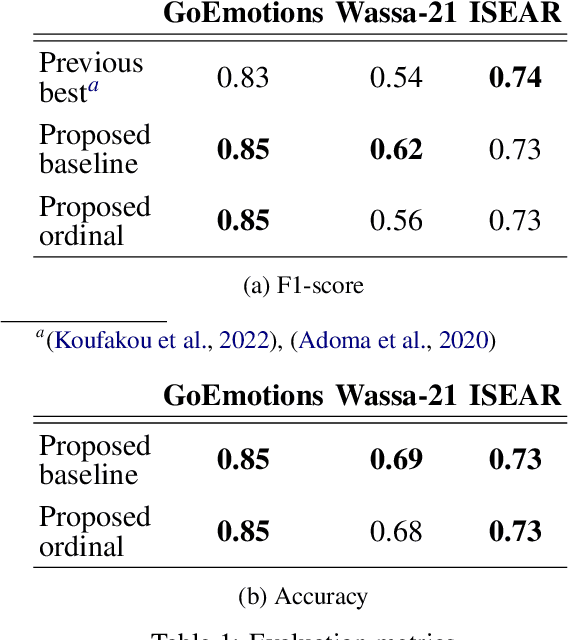
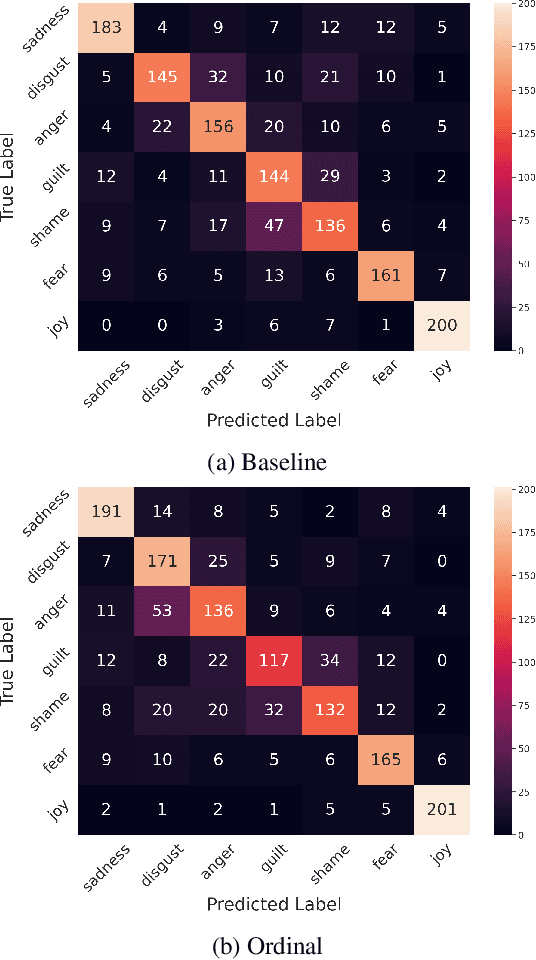
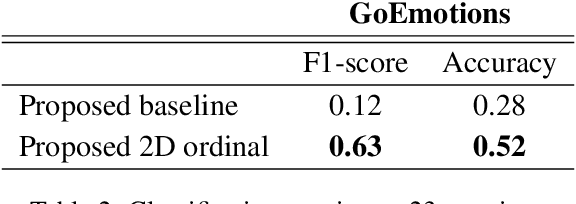
Abstract:Emotion detection in textual data has received growing interest in recent years, as it is pivotal for developing empathetic human-computer interaction systems. This paper introduces a method for categorizing emotions from text, which acknowledges and differentiates between the diversified similarities and distinctions of various emotions. Initially, we establish a baseline by training a transformer-based model for standard emotion classification, achieving state-of-the-art performance. We argue that not all misclassifications are of the same importance, as there are perceptual similarities among emotional classes. We thus redefine the emotion labeling problem by shifting it from a traditional classification model to an ordinal classification one, where discrete emotions are arranged in a sequential order according to their valence levels. Finally, we propose a method that performs ordinal classification in the two-dimensional emotion space, considering both valence and arousal scales. The results show that our approach not only preserves high accuracy in emotion prediction but also significantly reduces the magnitude of errors in cases of misclassification.
Low-Resource Cross-Domain Singing Voice Synthesis via Reduced Self-Supervised Speech Representations
Feb 02, 2024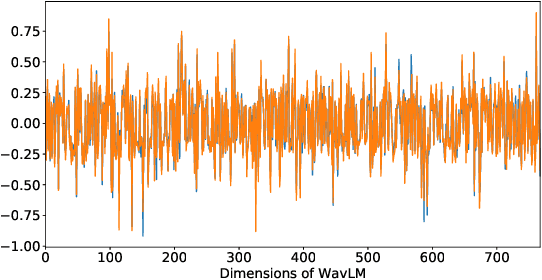

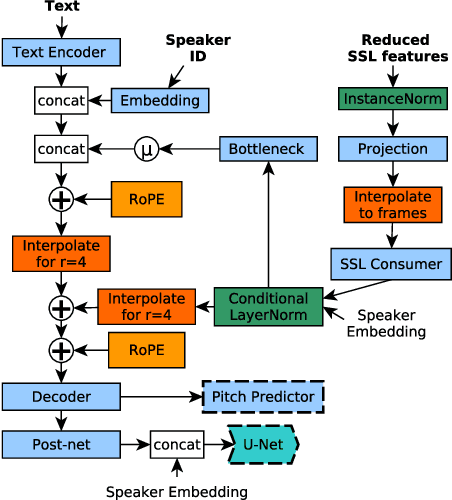
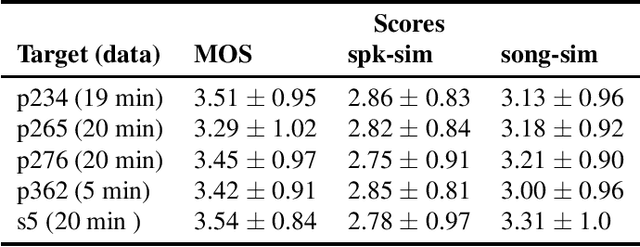
Abstract:In this paper, we propose a singing voice synthesis model, Karaoker-SSL, that is trained only on text and speech data as a typical multi-speaker acoustic model. It is a low-resource pipeline that does not utilize any singing data end-to-end, since its vocoder is also trained on speech data. Karaoker-SSL is conditioned by self-supervised speech representations in an unsupervised manner. We preprocess these representations by selecting only a subset of their task-correlated dimensions. The conditioning module is indirectly guided to capture style information during training by multi-tasking. This is achieved with a Conformer-based module, which predicts the pitch from the acoustic model's output. Thus, Karaoker-SSL allows singing voice synthesis without reliance on hand-crafted and domain-specific features. There are also no requirements for text alignments or lyrics timestamps. To refine the voice quality, we employ a U-Net discriminator that is conditioned on the target speaker and follows a Diffusion GAN training scheme.
Generating Gender-Ambiguous Text-to-Speech Voices
Nov 01, 2022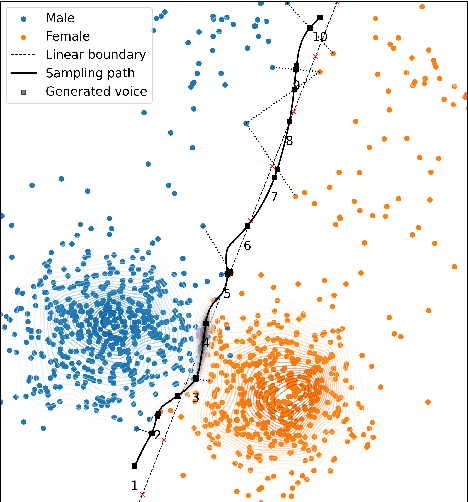


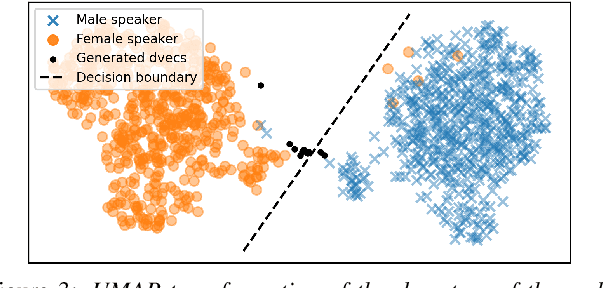
Abstract:The gender of a voice assistant or any voice user interface is a central element of its perceived identity. While a female voice is a common choice, there is an increasing interest in alternative approaches where the gender is ambiguous rather than clearly identifying as female or male. This work addresses the task of generating gender-ambiguous text-to-speech (TTS) voices that do not correspond to any existing person. This is accomplished by sampling from a latent speaker embeddings' space that was formed while training a multilingual, multi-speaker TTS system on data from multiple male and female speakers. Various options are investigated regarding the sampling process. In our experiments, the effects of different sampling choices on the gender ambiguity and the naturalness of the resulting voices are evaluated. The proposed method is shown able to efficiently generate novel speakers that are superior to a baseline averaged speaker embedding. To our knowledge, this is the first systematic approach that can reliably generate a range of gender-ambiguous voices to meet diverse user requirements.
Cross-lingual Text-To-Speech with Flow-based Voice Conversion for Improved Pronunciation
Oct 31, 2022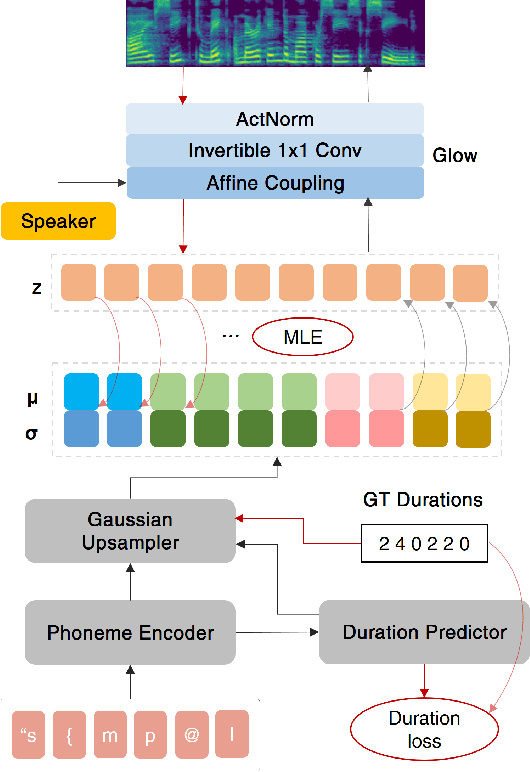
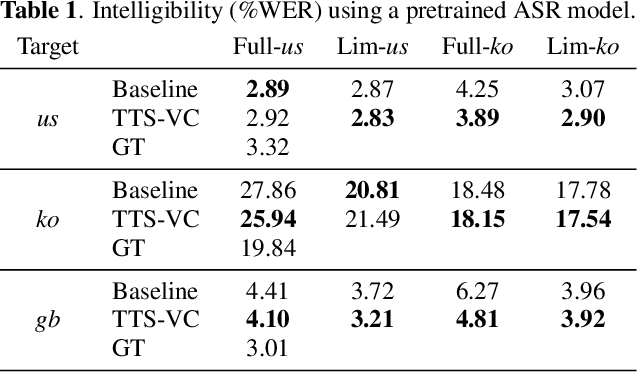

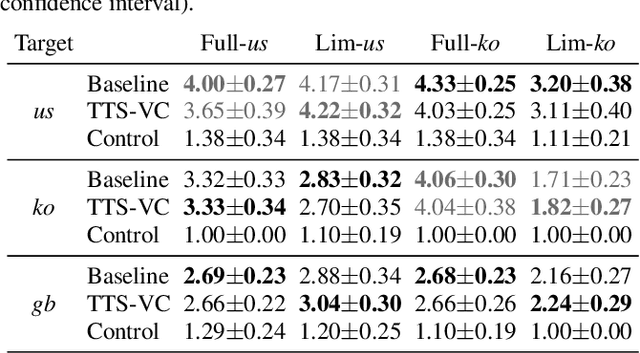
Abstract:This paper presents a method for end-to-end cross-lingual text-to-speech (TTS) which aims to preserve the target language's pronunciation regardless of the original speaker's language. The model used is based on a non-attentive Tacotron architecture, where the decoder has been replaced with a normalizing flow network conditioned on the speaker identity, allowing both TTS and voice conversion (VC) to be performed by the same model due to the inherent linguistic content and speaker identity disentanglement. When used in a cross-lingual setting, acoustic features are initially produced with a native speaker of the target language and then voice conversion is applied by the same model in order to convert these features to the target speaker's voice. We verify through objective and subjective evaluations that our method can have benefits compared to baseline cross-lingual synthesis. By including speakers averaging 7.5 minutes of speech, we also present positive results on low-resource scenarios.
Karaoker: Alignment-free singing voice synthesis with speech training data
Apr 08, 2022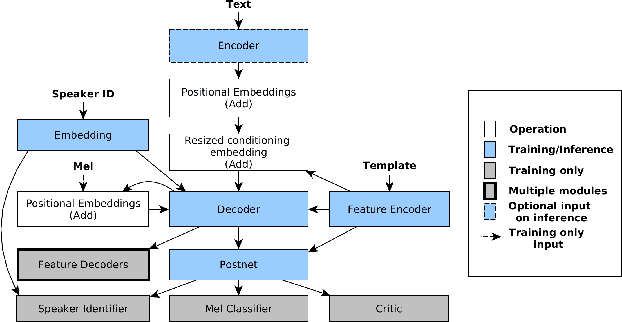

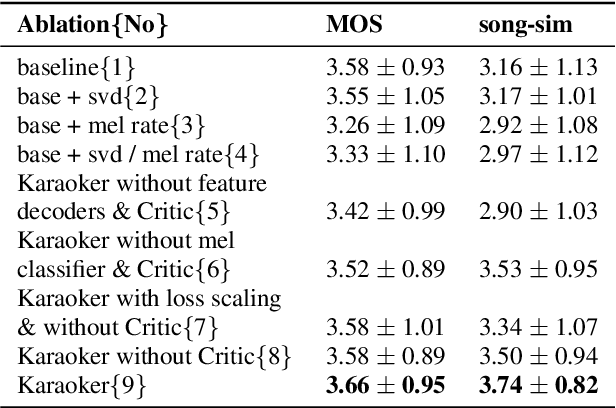
Abstract:Existing singing voice synthesis models (SVS) are usually trained on singing data and depend on either error-prone time-alignment and duration features or explicit music score information. In this paper, we propose Karaoker, a multispeaker Tacotron-based model conditioned on voice characteristic features that is trained exclusively on spoken data without requiring time-alignments. Karaoker synthesizes singing voice following a multi-dimensional template extracted from a source waveform of an unseen speaker/singer. The model is jointly conditioned with a single deep convolutional encoder on continuous data including pitch, intensity, harmonicity, formants, cepstral peak prominence and octaves. We extend the text-to-speech training objective with feature reconstruction, classification and speaker identification tasks that guide the model to an accurate result. Except for multi-tasking, we also employ a Wasserstein GAN training scheme as well as new losses on the acoustic model's output to further refine the quality of the model.
Self supervised learning for robust voice cloning
Apr 07, 2022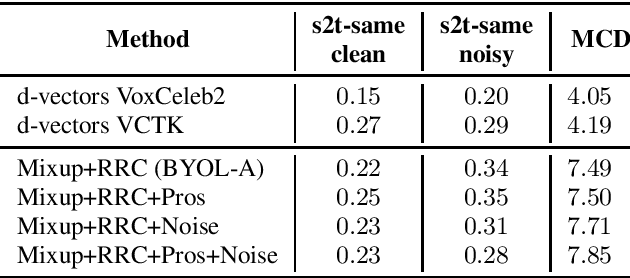
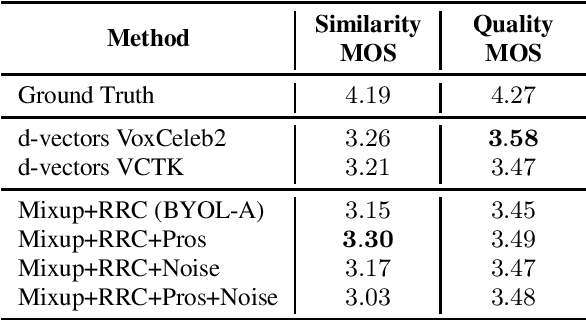
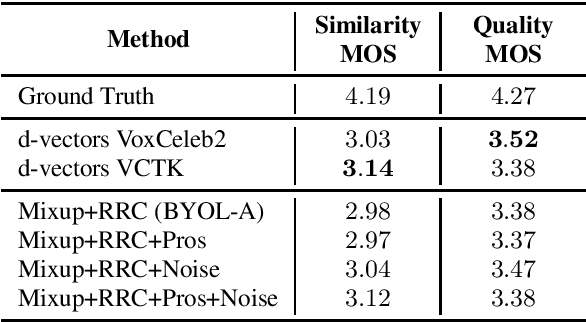
Abstract:Voice cloning is a difficult task which requires robust and informative features incorporated in a high quality TTS system in order to effectively copy an unseen speaker's voice. In our work, we utilize features learned in a self-supervised framework via the Bootstrap Your Own Latent (BYOL) method, which is shown to produce high quality speech representations when specific audio augmentations are applied to the vanilla algorithm. We further extend the augmentations in the training procedure to aid the resulting features to capture the speaker identity and to make them robust to noise and acoustic conditions. The learned features are used as pre-trained utterance-level embeddings and as inputs to a Non-Attentive Tacotron based architecture, aiming to achieve multispeaker speech synthesis without utilizing additional speaker features. This method enables us to train our model in an unlabeled multispeaker dataset as well as use unseen speaker embeddings to copy a speaker's voice. Subjective and objective evaluations are used to validate the proposed model, as well as the robustness to the acoustic conditions of the target utterance.
Prosodic Clustering for Phoneme-level Prosody Control in End-to-End Speech Synthesis
Nov 19, 2021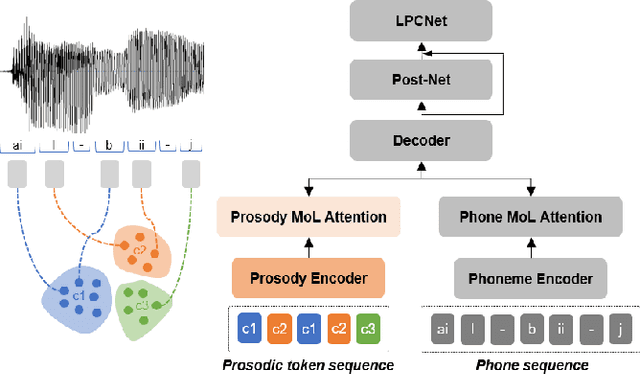
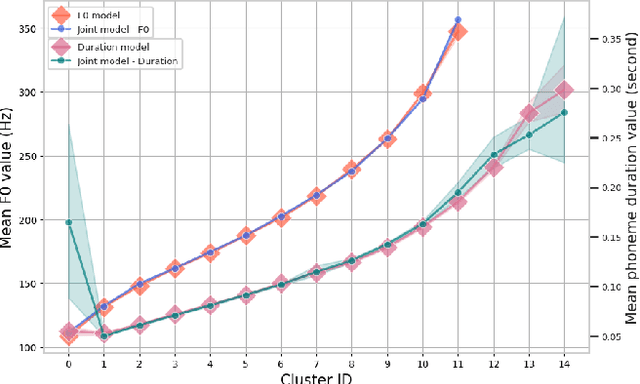
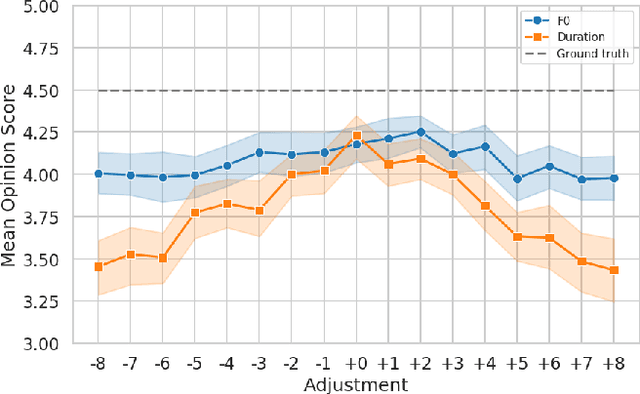
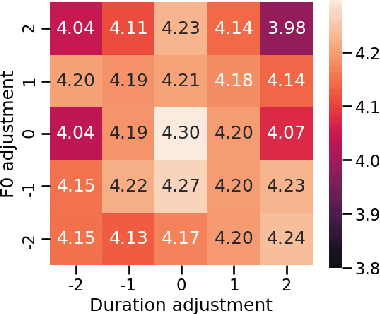
Abstract:This paper presents a method for controlling the prosody at the phoneme level in an autoregressive attention-based text-to-speech system. Instead of learning latent prosodic features with a variational framework as is commonly done, we directly extract phoneme-level F0 and duration features from the speech data in the training set. Each prosodic feature is discretized using unsupervised clustering in order to produce a sequence of prosodic labels for each utterance. This sequence is used in parallel to the phoneme sequence in order to condition the decoder with the utilization of a prosodic encoder and a corresponding attention module. Experimental results show that the proposed method retains the high quality of generated speech, while allowing phoneme-level control of F0 and duration. By replacing the F0 cluster centroids with musical notes, the model can also provide control over the note and octave within the range of the speaker.
Improved Prosodic Clustering for Multispeaker and Speaker-independent Phoneme-level Prosody Control
Nov 19, 2021
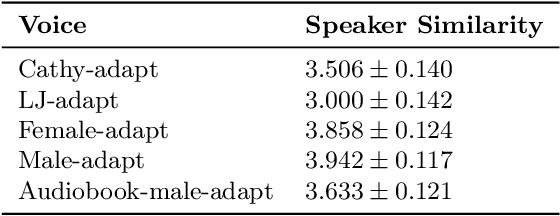
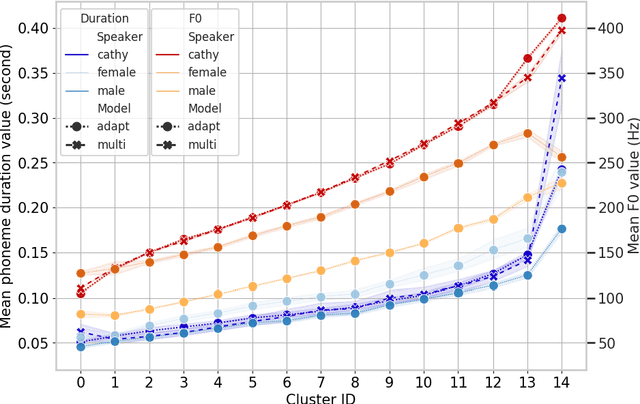
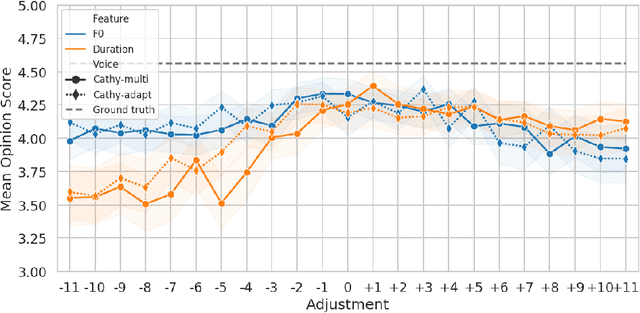
Abstract:This paper presents a method for phoneme-level prosody control of F0 and duration on a multispeaker text-to-speech setup, which is based on prosodic clustering. An autoregressive attention-based model is used, incorporating multispeaker architecture modules in parallel to a prosody encoder. Several improvements over the basic single-speaker method are proposed that increase the prosodic control range and coverage. More specifically we employ data augmentation, F0 normalization, balanced clustering for duration, and speaker-independent prosodic clustering. These modifications enable fine-grained phoneme-level prosody control for all speakers contained in the training set, while maintaining the speaker identity. The model is also fine-tuned to unseen speakers with limited amounts of data and it is shown to maintain its prosody control capabilities, verifying that the speaker-independent prosodic clustering is effective. Experimental results verify that the model maintains high output speech quality and that the proposed method allows efficient prosody control within each speaker's range despite the variability that a multispeaker setting introduces.
Rapping-Singing Voice Synthesis based on Phoneme-level Prosody Control
Nov 17, 2021
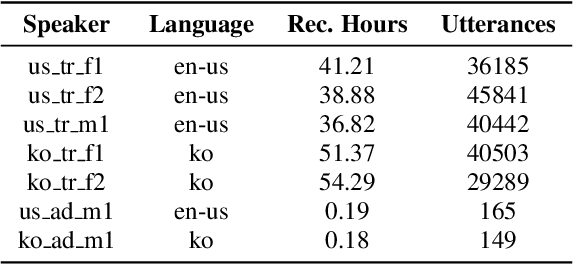
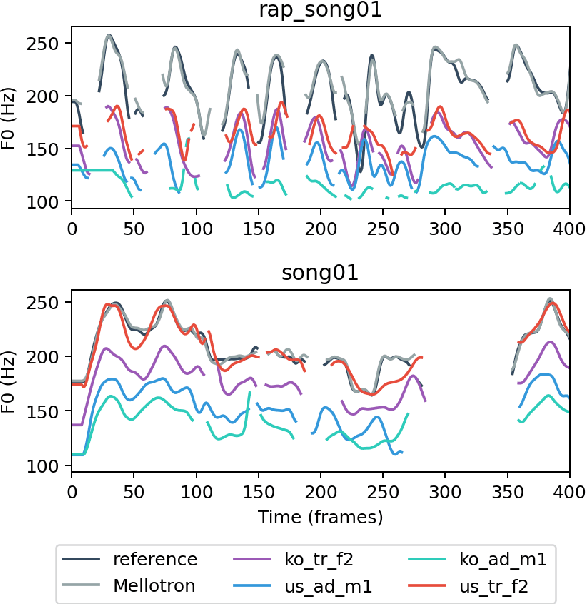
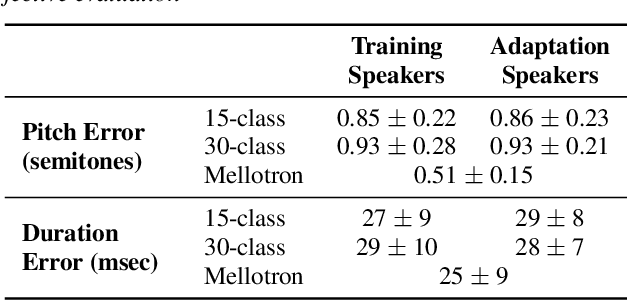
Abstract:In this paper, a text-to-rapping/singing system is introduced, which can be adapted to any speaker's voice. It utilizes a Tacotron-based multispeaker acoustic model trained on read-only speech data and which provides prosody control at the phoneme level. Dataset augmentation and additional prosody manipulation based on traditional DSP algorithms are also investigated. The neural TTS model is fine-tuned to an unseen speaker's limited recordings, allowing rapping/singing synthesis with the target's speaker voice. The detailed pipeline of the system is described, which includes the extraction of the target pitch and duration values from an a capella song and their conversion into target speaker's valid range of notes before synthesis. An additional stage of prosodic manipulation of the output via WSOLA is also investigated for better matching the target duration values. The synthesized utterances can be mixed with an instrumental accompaniment track to produce a complete song. The proposed system is evaluated via subjective listening tests as well as in comparison to an available alternate system which also aims to produce synthetic singing voice from read-only training data. Results show that the proposed approach can produce high quality rapping/singing voice with increased naturalness.
High Quality Streaming Speech Synthesis with Low, Sentence-Length-Independent Latency
Nov 17, 2021
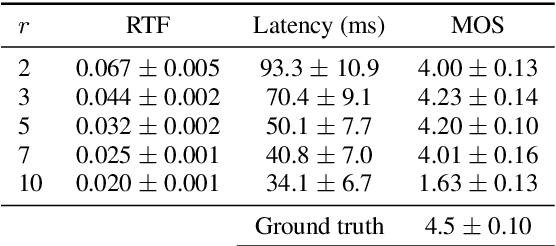
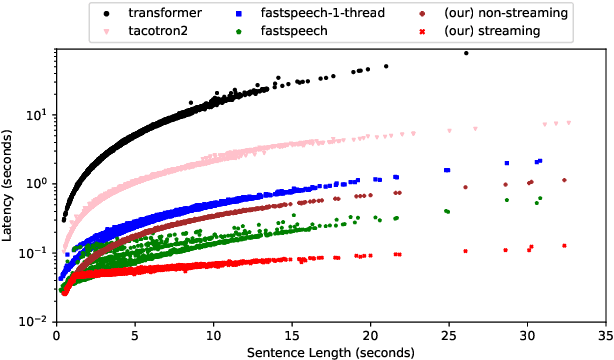
Abstract:This paper presents an end-to-end text-to-speech system with low latency on a CPU, suitable for real-time applications. The system is composed of an autoregressive attention-based sequence-to-sequence acoustic model and the LPCNet vocoder for waveform generation. An acoustic model architecture that adopts modules from both the Tacotron 1 and 2 models is proposed, while stability is ensured by using a recently proposed purely location-based attention mechanism, suitable for arbitrary sentence length generation. During inference, the decoder is unrolled and acoustic feature generation is performed in a streaming manner, allowing for a nearly constant latency which is independent from the sentence length. Experimental results show that the acoustic model can produce feature sequences with minimal latency about 31 times faster than real-time on a computer CPU and 6.5 times on a mobile CPU, enabling it to meet the conditions required for real-time applications on both devices. The full end-to-end system can generate almost natural quality speech, which is verified by listening tests.
 Add to Chrome
Add to Chrome Add to Firefox
Add to Firefox Add to Edge
Add to Edge